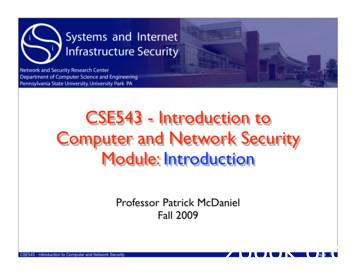CSE543 - Introduction To Computer And Network Security .
II3YSTEMS AND )NTERNET)NFRASTRUCTURE 3ECURITY.ETWORK AND 3ECURITY 2ESEARCH #ENTER EPARTMENT OF #OMPUTER 3CIENCE AND %NGINEERING0ENNSYLVANIA 3TATE 5NIVERSITY 5NIVERSITY 0ARK 0!CSE543 - Introduction toComputer and Network SecurityModule: IntroductionProfessor Patrick McDanielFall 2009CSE543 - Introduction to Computer and Network SecurityPage 1
Some bedtime stories CSE543 - Introduction to Computer and Network SecurityPage 2
This course We are going to explore why these events are notisolated, infrequent, or even unexpected. Why are we doing so poorly in computing systems atprotecting our users and data from inadvertent orintentional harm?The answer: stay tuned!CSE543 - Introduction to Computer and Network SecurityPage 3
This course . This course is a systems coursecovering general topics incomputer and network security,including:‣ network security, authentication,security protocol design and analysis,social engineering, key management,program safety, intrusion detection,DDOS detection and mitigation,architecture/operating systemssecurity, security policy, group systems,biometrics, web security, languagebased security, and other emergingtopics (as time permits)CSE543 - Introduction to Computer and Network SecurityPage 4
You need to understand . IP Networks Modern Operating Systems Discrete Mathematics Basics of systems theory and implementation‣ E.g., File systems, distributed systems, networking, operatingsystems, .CSE543 - Introduction to Computer and Network SecurityPage 5
Goals‣ My goal: to provide you with the tools to understand andevaluate research in computer security.‣ Basic technologies‣ Engineering/research trade-offs‣ How to read/write/present security research papers This is going to be a hard course. The key to success issustained effort. Failure to keep up with readings andproject will likely result in poor grades, and ultimately littleunderstanding of the course material. Pay-off: security competence is a rare, valuable skillCSE543 - Introduction to Computer and Network SecurityPage 6
Course Materials Website - I am maintaining the course website at‣ http://www.cse.psu.edu/ mcdaniel/cse543-f09/ Course assignments, slides, and other artifacts will bemade available on the course website. Course textbook‣ Kaufman, C., Perlman, R. and Speciner, M., Network Security(Private Communication in a Public World), 2nd edition,Prentice Hall 2002.CSE543 - Introduction to Computer and Network SecurityPage 7
Course Calendar The course calendar as all therelevant readings, assignments andtest dates The calendar page containselectronic links to online papersassigned for course readings. Please check the website frequentlyfor announcements and changes tothe schedule. Students areresponsible for any change on theschedule.CSE543 - Introduction to Computer and Network SecurityPage 8
Grading The course will be graded on exams, quizzes,assignments, projects, and class participation in thefollowing proportions:30% Course Research Project15% Quizzes20% Mid-term Exam30% Final Exam10% Class ParticipationCSE543 - Introduction to Computer and Network SecurityPage 9
Assignments, Quizzes, Reviews Exams‣ Conceptual Questions (Basic and Complex)‣ Constructions‣ Precise Answers Quizzes‣ Quick quizzes on the previous lecture and readings‣ Review of Papers (for each class) Define Concepts Comparison with Other Approaches Details of Approach Written and Oral Reviewing Are ImportantCSE543 - Introduction to Computer and Network SecurityPage 10
Readings There are a large amount of readings in this coursecovering various topics. These assignments areintended to:‣ Support the lectures in the course (provide clarity)‣ Augment the lectures and provide a broader exposure tosecurity topics. Students are required to do the reading! About 10-20% of questions on the tests (and most of thequizes) will be off the reading on topics that were notcovered in class. You better do the reading or you aregoing to be in deep trouble when it comes to grades.CSE543 - Introduction to Computer and Network SecurityPage 11
Course Project End Result: Research Paper‣ Motivation for an Experiment‣ Background‣ Related Work‣ Experimental Approach‣ Experimental Evaluation I will provide sample topic areas‣ General Areas Start with an Existing System/Approach‣ Break It Improve It‣ Aim for a Research-Quality ResultCSE543 - Introduction to Computer and Network SecurityPage 12
Ethics Statement This course considers topics involving personal and public privacy andsecurity. As part of this investigation we will cover technologieswhose abuse may infringe on the rights of others. As an instructor, Irely on the ethical use of these technologies. Unethical use mayinclude circumvention of existing security or privacy measurementsfor any purpose, or the dissemination, promotion, or exploitation ofvulnerabilities of these services. Exceptions to these guidelines mayoccur in the process of reporting vulnerabilities through public andauthoritative channels. Any activity outside the letter or spirit ofthese guidelines will be reported to the proper authorities and mayresult in dismissal from the class and or institution. When in doubt, please contact the instructor for advice. Do notundertake any action which could be perceived as technology misuseanywhere and/or under any circumstances unless you have receivedexplicit permission from Professor McDaniel.CSE543 - Introduction to Computer and Network SecurityPage 13
What is security? Garfinkel and Spafford (1991)‣ “A computer is secure if you can depend on it andits software to behave as expected.” Harrison, Ruzzo, Ullman (1978)‣ “Prevent access by unauthorized users” Not really satisfactory – does not truly capturethat security speaks to the behavior of others‣ Expected by whom?‣ Under what circumstances?CSE543 - Introduction to Computer and Network SecurityPage 14
Risk At-risk valued resources that can be misused‣ Monetary‣ Data (loss or integrity)‣ Time‣ Confidence‣ Trust What does being misused mean?‣ Privacy (personal)‣ Confidentiality (communication)‣ Integrity (personal or communication) Availability (existential or fidelity) Q: What is at stake in your life?CSE543 - Introduction to Computer and Network SecurityPage 15
Threats A threat is a specific means by which an attacker can put asystem at risk‣ An ability/goal of an attacker (e.g., eavesdrop , fraud, access denial)‣ Independent of what can be compromised A threat model is a collection of threats that deemedimportant for a particular environment‣ A collection of attacker(s) abilities‣ E.g., A powerful attacker can read and modify all communications andgenerate messages on a communication channel Q: What were risks/threats in the introductory examples?‣ ZDNet‣ Yale/Princeton‣ EstoniaCSE543 - Introduction to Computer and Network SecurityPage 16
Vulnerabilities (attack vectors) A vulnerability is a systematic artifact thatexposes the user, data, or system to a threat E.g., buffer-overflow, WEP key leakage What is the source of a vulnerability?‣ Bad software (or hardware)‣ Bad design, requirements‣ Bad policy/configuration‣ System Misuse‣ Unintended purpose or environment E.g., student IDs for liquor storeCSE543 - Introduction to Computer and Network SecurityPage 17
Adversary An adversary is any entity trying tocircumvent the security infrastructure‣ The curious and otherwise generally clueless (e.g., script-kiddies)‣ Casual attackers seeking to understand systems‣ Venal people with an ax to grind‣ Malicious groups of largely sophisticated users (e.g, chaos clubs)‣ Competitors (industrial espionage)‣ Governments (seeking to monitor activities)CSE543 - Introduction to Computer and Network SecurityPage 18
Are users adversaries? Have you ever tried to circumvent the security of asystem you were authorized to access? Have you ever violated a security policy (knowingly orthrough carelessness)?This is know as the insider adversary!CSE543 - Introduction to Computer and Network SecurityPage 19
Attacks An attack occurs when someone attempts to exploit avulnerability Kinds of attacks‣ Passive (e.g., eavesdropping)‣ Active (e.g., password guessing)‣ Denial of Service (DOS) Distributed DOS – using many endpoints A compromise occurs when an attack is successful‣ Typically associated with taking over/altering resourcesCSE543 - Introduction to Computer and Network SecurityPage 20
Participants Participants are expected system entities‣ Computers, agents, people, enterprises, ‣ Depending on context referred to as: servers, clients, users,entities, hosts, routers, ‣ Security is defined with respect to these entitles Implication: every party may have unique view A trusted third party‣ Trusted by all parties for some set of actions‣ Often used as introducer or arbiterCSE543 - Introduction to Computer and Network SecurityPage 21
Trust Trust refers to the degree to which an entity isexpected to behave What the entity not expected to do?‣ E.g., not expose password What the entity is expected to do (obligations)?‣ E.g., obtain permission, refresh A trust model describes, for a particular environment,who is trusted to do what? Note: you make trust decisions every day‣ Q: What are they?‣ Q: Whom do you trust?CSE543 - Introduction to Computer and Network SecurityPage 22
Security Model A security model is the combination of a trust and threatmodels that address the set of perceived risks‣ The “security requirements” used to develop some cogent andcomprehensive design‣ Every design must have security model LAN network or global information system Java applet or operating system The single biggest mistake seen in use of security is the lack of acoherent security model‣ It is very hard to retrofit security (design time) This class is going to talk a lot about security models‣ What are the security concerns (risks)?‣ What are the threats?‣ Who are our adversaries?CSE543 - Introduction to Computer and Network SecurityPage 23
A Security Model Example Assume we have a University website that hostscourses through the web (e.g., Angel)‣ Syllabus, other course information‣ Assignments submissions‣ Online Grading In class: elements of the security model‣ Participants (Trusted)‣ Adversaries‣ Risks‣ ThreatsCSE543 - Introduction to Computer and Network SecurityPage 24
The single biggest mistake seen in use of security is the lack of a coherent security model ‣ It is very hard to retrofit security (design time) This class is going to talk a lot about security models ‣ What are the security concerns (risks)? ‣ What are the threats? ‣ Who are our adversaries? 23
CSE543 - Introduction to Computer and Network Security Page Goals ‣ My goal: to provide you with the tools to understand and evaluate research in computer security. ‣ Basic technologies ‣ Engineering/research trade-offs ‣ How to read/understand security research papers This is going to be a hard course. The key to success is .
CSE543 - Introduction to Computer and Network Security Page Access Control Policy Access control policy determines what operations a particular subject can perform for a set of objects It answers the questions ‣ E.g., do you have the permission to read /etc/passwd ‣ Does Alice have the permission to view the CSE webs
CSE543 - Introduction to Computer and Network Security Page Security Concerns Various attacks were being launched against Windows systems, essentially compromising all Concerns that Linux could also be prone ‣ “Inevitability of Failure” paper Any system with network facing daemons (e.g., sshd, f
work/products (Beading, Candles, Carving, Food Products, Soap, Weaving, etc.) ⃝I understand that if my work contains Indigenous visual representation that it is a reflection of the Indigenous culture of my native region. ⃝To the best of my knowledge, my work/products fall within Craft Council standards and expectations with respect to
1. Computer Fundamentals by P.K.Sinha _ Unit I: Introduction to Computers: Introduction, Definition, .Characteristics of computer, Evolution of Computer, Block Diagram Of a computer, Generations of Computer, Classification Of Computers, Applications of Computer, Capabilities and limitations of computer. Unit II: Basic Computer Organization:
What is Computer Architecture? “Computer Architecture is the science and art of selecting and interconnecting hardware components to create computers that meet functional, performance and cost goals.” - WWW Computer Architecture Page An analogy to architecture of File Size: 1MBPage Count: 12Explore further(PDF) Lecture Notes on Computer Architecturewww.researchgate.netComputer Architecture - an overview ScienceDirect Topicswww.sciencedirect.comWhat is Computer Architecture? - Definition from Techopediawww.techopedia.com1. An Introduction to Computer Architecture - Designing .www.oreilly.comWhat is Computer Architecture? - University of Washingtoncourses.cs.washington.eduRecommended to you b
Some common terms Desktop - a computer fitted on a work desk for personal use, not easily carried Laptop - an "all-in-one" (display, keyboard), fairly light and portable Personal computer (PC) - a computer for personal use Server computer - a computer that provides services Client computer - a computer that makes use of the services of a server .
Anatomy and Physiology for Sports Massage 11. LEVEL: 3: Term: Definition: Visuals: Cytoplasm Within cells, the cytoplasm is made up of a jelly-like fluid (called the cytosol) and other : structures that surround the nucleus. Cytoskeleton The cytoskeleton is a network of long fibres that make up the cell’s structural framework. The cytoskeleton has several critical functions, including .






















